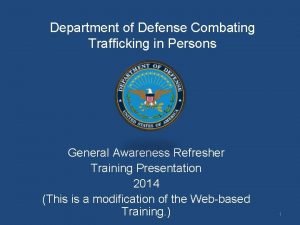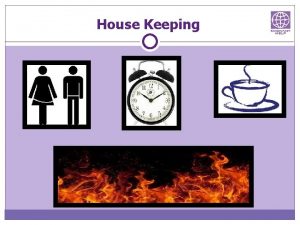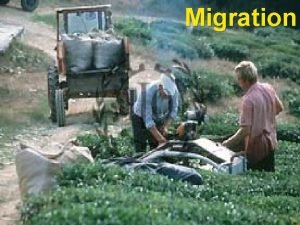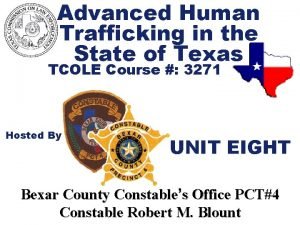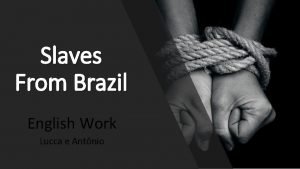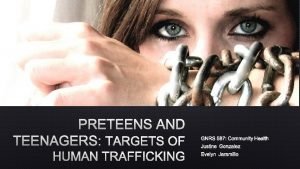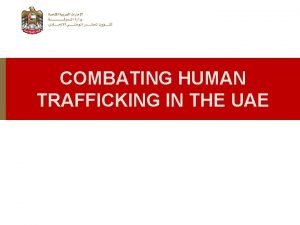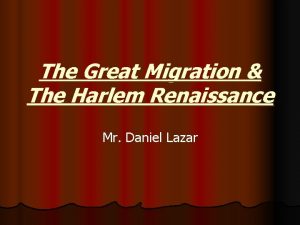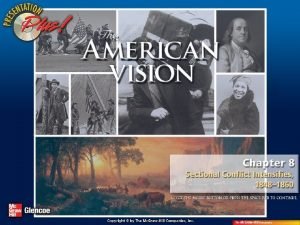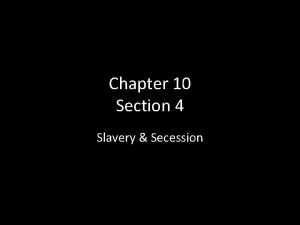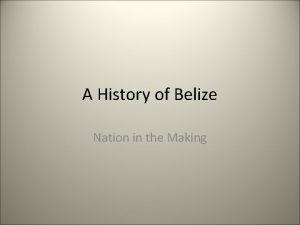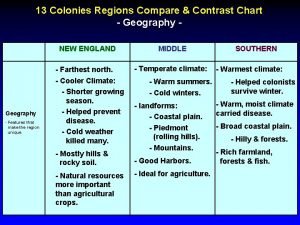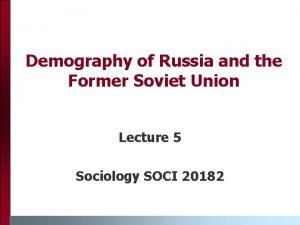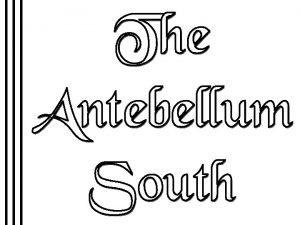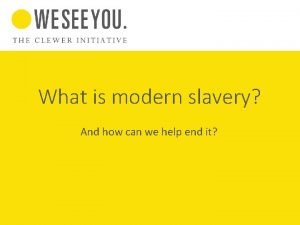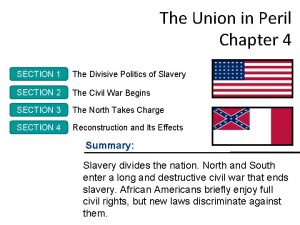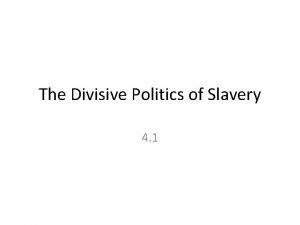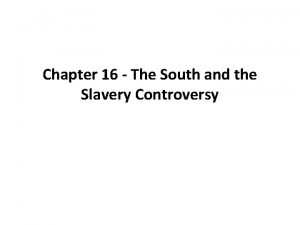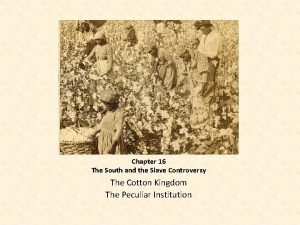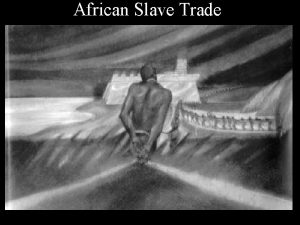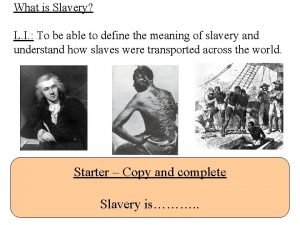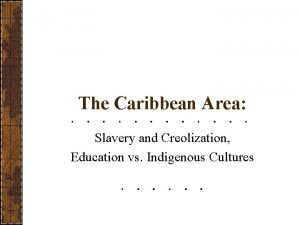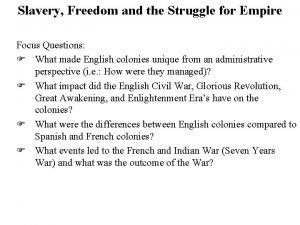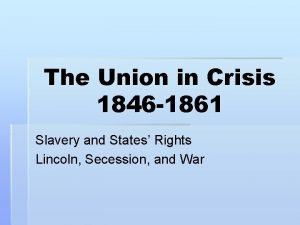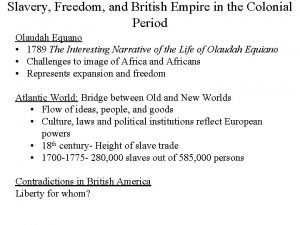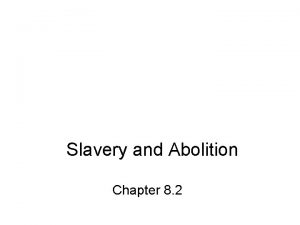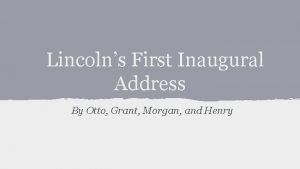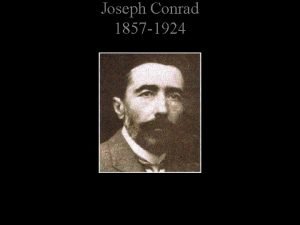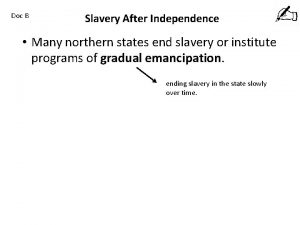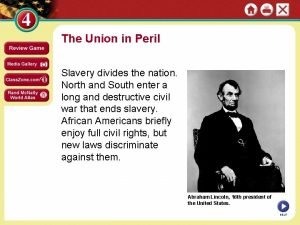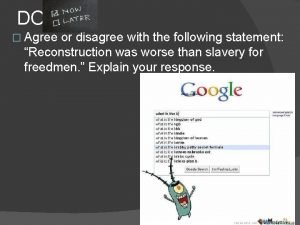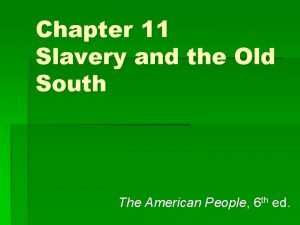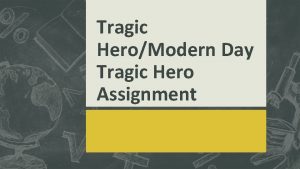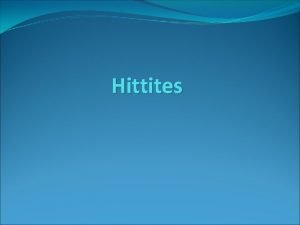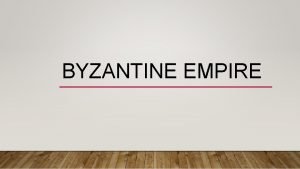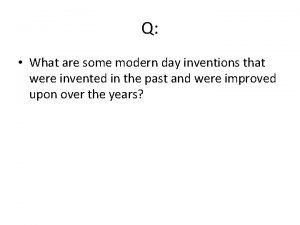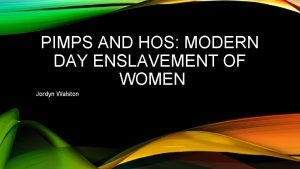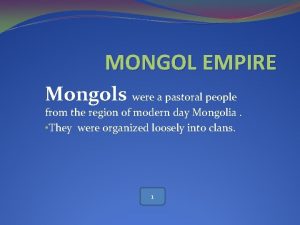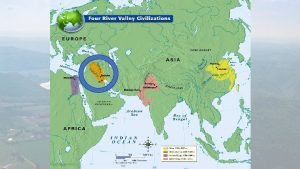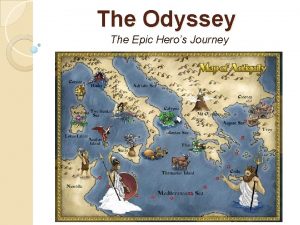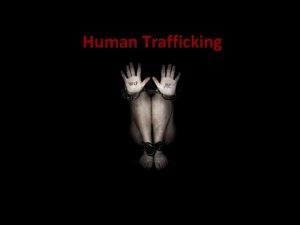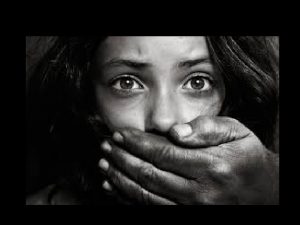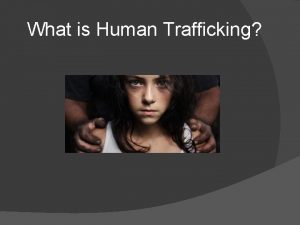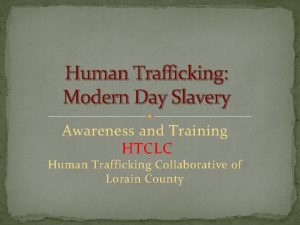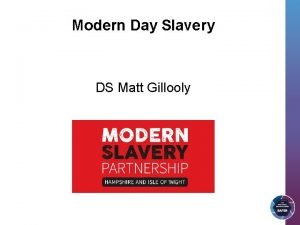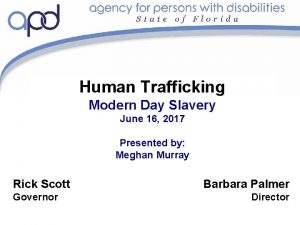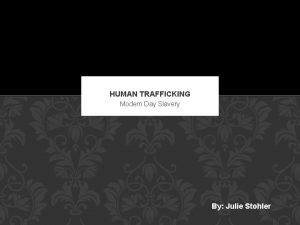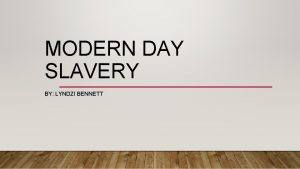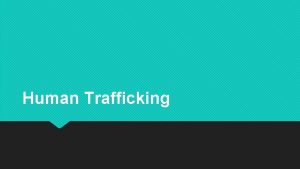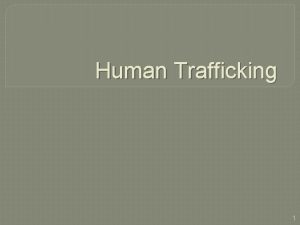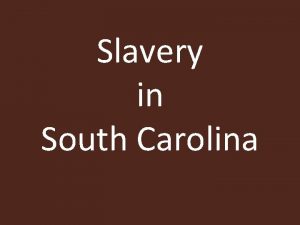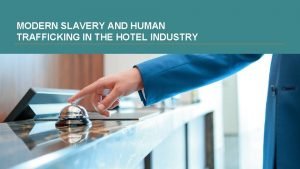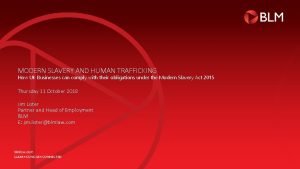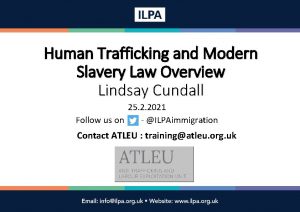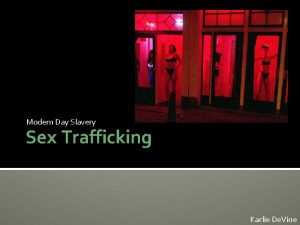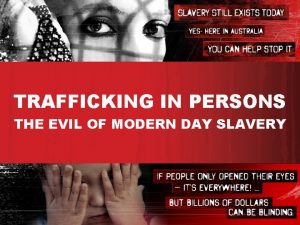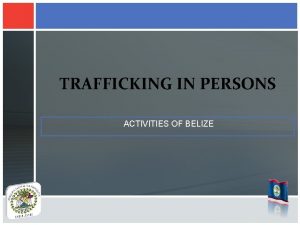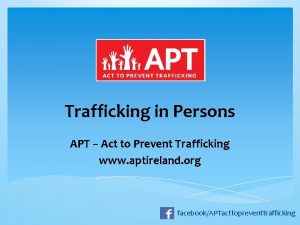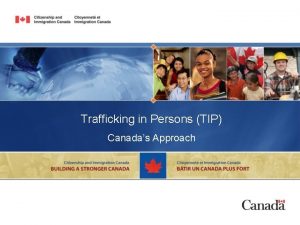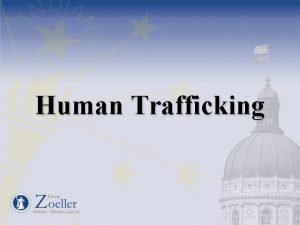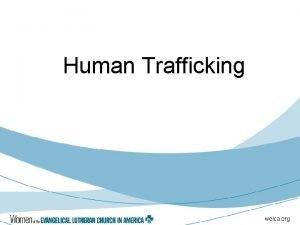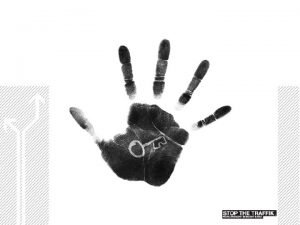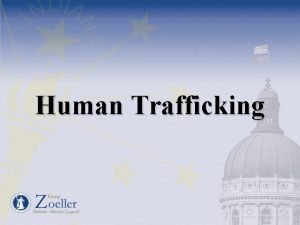HUMAN TRAFFICKING TRAFFICKING IN PERSONS MODERN DAY SLAVERY















































![…. . . . “It [history] determines in advance both what seems to us …. . . . “It [history] determines in advance both what seems to us](https://slidetodoc.com/presentation_image_h2/b1524b7c139c1cabf60a78a3ca811425/image-48.jpg)













- Slides: 61


HUMAN TRAFFICKING, TRAFFICKING IN PERSONS, MODERN DAY SLAVERY Marcel van der Watt

Legislative Framework

Background … § 15 November 2000 - UN General Assembly adopted the Convention against Transnational Organised Crime along with three protocols which served as additional instruments to supplement the Convention § 20 February 2004 - South Africa ratified the Palermo Protocol - develop laws which protect the victims of trafficking and prosecute offenders in a manner that is appropriate to the seriousness of the offence

Background … § Child Care Act 38 of 2005 (Sections 284, 285 & 287) 'Trafficking in Children’ § Sexual Offences Act 32 of 2007 (Section 71) 'Trafficking in Persons for the purpose of Sexual Exploitation' § 9 August 2015: Prevention and Combating of Trafficking in Persons Act 7 of 2013

Definition… Section 4 (1) Any person who delivers, recruits, transports, transfers, harbours, sells, exchanges, leases or receives another person within or across the borders Illegal or undocumented of the Republic, by means of person; Pregnancy; (a) a threat of harm; Disability of a person; Addiction (Drugs); Being a child; (b) the threat or use of force or other forms Social & Economic circumstances of coercion; (c) the abuse of vulnerability; (d) fraud;

Definition… (e) deception; (f) abduction; (g) kidnapping; (h) the abuse of power; (i) the direct or indirect giving or receiving of payments or benefits to obtain the consent of a person having control or authority over another person; or (j) the direct or indirect giving or receiving of payments, compensation, rewards, benefits or any other advantage,

Definition… aimed at either the person or an immediate family member of that person or any other person in close relationship to that person, for the purpose of any form or manner of exploitation, is guilty of the offence of trafficking in persons

Definition… 4 (2) Any person who— (a) adopts a child, facilitated or secured through legal or illegal means; or (b) concludes a forced marriage with another person, within or across the borders of the Republic, for the purpose of the exploitation of that child or other person in any form or manner, is guilty of an offence

Definition… ‘‘abuse of vulnerability’’ for purposes of section 4(1), means any abuse that leads a person to believe that he or she has no reasonable alternative but to submit to exploitation, and includes but is not limited to, taking advantage of the vulnerabilities of that person resulting from— (a) the person having entered or remained in the Republic illegally or without proper documentation; (b) pregnancy; (c) any disability of the person; (d) addiction to the use of any dependence-producing substance; (e) being a child; (f) social circumstances; or (g) economic circumstances

Definition… ‘‘debt bondage’’ means the involuntary status or condition that arises from a pledge by a person of— (a) his or her personal services; or (b) the personal services of another person under his or her control, as security for a debt owed, or claimed to be owed, including any debt incurred or claimed to be incurred after the pledge is given, by that person if the— (i) debt owed or claimed to be owed, as reasonably assessed, is manifestly excessive; (ii) length and nature of those services are not respectively limited and defined; or (iii) value of those services as reasonably assessed is not applied towards the liquidation of the debt or purported debt

Definition… ‘‘carrier’’ includes a person who is the owner or employee of the owner, an agent, an operator, a lessor, a driver, a charterer or a master, of any means of transport

Other crimes & issues addressed § Section 5 ‘Debt bondage’ § Section 6 ‘Possession, destruction, confiscation, concealment of or tampering with documents’ § Section 7 ‘Using services of VOTs’ § Section 8 ‘Conduct facilitating TIP’ § Section 9 ‘Liability of carriers’

A Complex Range of Crimes Withholding identity papers and documents Involuntary Servitude Cable or theft Forced compulsory labour. General theft practices e. g Slavery-like 3 rd Party – Alleged Forcedtheft abortion Cruel, inhumane or degrading treatment e. g assault Damage to property Illegal Fishing Trespass/Illegal Sexual assault and Rape Slavery Immigrants Debt-bondage Break – ins/House Forced pregnancy breaking and theft Stowaways: Kidnapping Forced Marriage Inbound Outbound Murder Torture Assault: Common Grievous Bodily Harm Corruption Unlawful Child(GBH) Care Act related offences confinement Fraud Forced drug inducement Drugs Money Laundering and Tax evasion Document Theft Death Immigration-related offences Body Found Injury on duty (IOD) Fraud, Forgery and Uttering

A complex phenomenon Individual trafficker Group working together Different groups in city Inter-city network National network Regional network Continental network International network


Human Trafficking vs Smuggling

DIFFERENCES TRAFFICKING SMUGGLING 1. How money is made Exploitation of victim in destination country Helping person to illegally cross the border 2. Consent / Agreement Potential victim agrees to travel on basis of false info Person agrees to travel with full info about journey, destination and costs 3. Relationship Trafficker-Victim: Smuggler-Client: Relationship continues in destination country Relationship ends once border is crossed into destination country 4. Who is affected Crime is against the person Crime is against the country 5. Borders Can be domestic or transnational; legally or illegally Needs to be transnational; always illegal








Forms of Trafficking in Persons in South Africa

Forced labour / Illegal mining Gangs / Weapons / Endangered species Smuggling-cum-trafficking & terror funding Pornography and trafficking The occult (grave digging, coven recruitment) Domestic servitude Criminal exploitation, gangs, street begging et al. Drug trafficking Organs / body parts [Adoption irregularities]

How Big is the Problem?

Reported missing persons: 1 January 2000 to 31 December 2015 Adults Reported missing from 2000/01/01 to 2015/12/31 49 346 Cancelled (found) from 2000/01/01 to 2015/12/31 25 543 Unaccounted for or still missing 23 803 Children (Under 18) Reported missing from 2000/01/01 to 2015/12/31 14 252 Cancelled (found) from 2000/01/01 to 2015/12/31 10 295 Unaccounted for or still missing 3957 Van der Watt, 2018

Reported TIP cases: 1 January 2006 to 12 December 2017 Prevention and Province Children’s Act 38 of 2005 Sexual Offences Act 32 of 2007 Combating of Trafficking in Persons Act 7 of 2013 Eastern Cape 0 24 212 Free State 1 15 72 Gauteng 3 63 810 KZN 3 17 378 Limpopo 1 7 160 Mpumalanga 2 19 176 North West 2 13 101 Northern Cape 0 7 33 Western Cape 2 23 190 TOTAL 14 188 2132 Van der Watt, 2018

Unidentified and Undocumented Cases … some “human trafficking stories sounds like a movie, and I’m sorry to say this, but people will listen to this and they think, no, this could never be happening” (NPA 2, para. 38) The police response to some of these reports: “So they stand there and it sounds so unbelievable that they immediately make a judgement call and say this person’s lying to them…” (NPA 2, para. 40)

Unidentified and Undocumented Cases “…we have +/- 8 other investigations running at the moment. Suffice to say that we have enough work to keep ourselves busy for a long time. Reality – we can’t really get to everything properly and many allegations are not investigated because of limited resources and manpower. ” (NPA 5, para. 40)

Control methods

Control methods “…in contrast to historical slavery systems characterised by whips, chains, and physical imprisonment, modern day slavery is less overt, typically with no obvious visible signs of restraint. Rather, psychological abuse, coercion and mental manipulation play a powerful role in forcing modern day slaves to work in a variety of industries” (Dando, Welsh & Brierly, 2016: 1)

Control methods Compliance of victims are integral to control methods used by traffickers; Control methods are used to circumvent and conceal criminal activities of traffickers; Guard against a reductionist / oversimplified description of control methods;

Control methods “The numerous and diverse interactions between the human actors in a trafficking process, and the interpenetration of dynamic circumstances, threats, space and time, means that different control methods should be viewed as a toolbox from which the trafficker choose as he or she deems fit…” (Van der Watt & Kruger, 2018)

Physical Coercive Control Methods Direct violence and various methods of physical assault Forcible confinement and surveillance Physical fatigue, neglect and induced debility Drug dependency

Non-Physical Coercive Control Methods Deception Debt bondage | Financial control Psychological control | Trauma bonding Relationship control Fear (motherhood, children, family etc. ) Isolation | Disorientation Confiscation of travel & identity documents Omnipresence | Omnipotence of trafficker

Non-Physical Coercive Control Methods Impregnation of VOTs Degradation & Shaming Branding Corruption & Collusion Abuse of vulnerability | Power Sextortion | Digital tattooing; and Cultural Customs | Belief Systems | Witchcraft | Occult Rituals | Superstition | Religion

Were you ever able to run away? VOT 4 “Yes, but the fear and fear to change. It was not only the fear of Nigerians, it was the fear of me changing that life that I’ve already living…’cause I was scared that if I run away what’s gonna happen to me? What am I gonna do? I started drugs when I was sixteen, I’m not qualified for anything. Will I ever get a job? A lot of things come into your mind…Then you rather let me stick to this life that I know that I’m used to even if I die…

Were you ever able to run away? VOT 4 Continue…So I realised that most of us we scared to change into that life because of the fear, a fear of change…because I’m so comfortable into me getting up five o’clock, taking my bath, the Nigerian say there’s your wake-up then I smoke it and stand in the street and I know I will make money the whole night. Daytime I sleep. So used to that. Now what’s gonna happen to me? How am I gonna live?

Were you ever able to run away? VOT 4 Continue…And the other thing you get it into your brains that once you hooked on drugs you’ll never stop and that thing also haunts you. How am I gonna survive with this thing? Because if you don’t smoke for two days your whole body you can feel it. You get sore, you get cramps, it’s a very hard thing to fight. So all those things they come into your mind. They built in then you realise, me, I’d rather stay…” (VOT 4, para. 162)

Responding to human trafficking

Prevention Raising awareness (education and sensitization) Research Seminars / networking Information campaigns Media Regional cooperation

Protection Shelter Medical / psychological assistance Visa options Voluntary return and reintegration Safety Information and awareness-raising Regional collaboration

Prosecution Strengthen laws Increase penalties Build capacity Cooperation - NGOs and law enforcement Transnational cooperation

Indicators of TIP, victim identification and screening
![It history determines in advance both what seems to us …. . . . “It [history] determines in advance both what seems to us](https://slidetodoc.com/presentation_image_h2/b1524b7c139c1cabf60a78a3ca811425/image-48.jpg)
…. . . . “It [history] determines in advance both what seems to us worth inquiring about and what will appear as an object of investigation, and we more or less forget half of what is really there – in fact, we miss the whole truth of the phenomenon – when we take its immediate appearance as the whole truth” Hans-Georg Gadamer

§ Consider the social context and the constellation of circumstances; § The nature of TIP (process, hidden & subversive nature); § An indicator(s) ≠ proof of TIP; § Generate enquiries & finding corroboration of accounts and observations; § Work towards understanding the mosaic of indicators – may be different for each case; § Is something emerging? What am I seeing? What are my colleagues/team seeing?

General indicators §Age §Gender §Location of origin (recruitment) §Documentation §Recent / Last location (exploitation) §Transportation / Mobilisation §Circumstances & Assessment of referral agency §Evidence of abuse §Current knowledge

General indicators § An unusual appearance of anxiety and unfamiliarity with surroundings § Possession of limited and similar types of baggage § Unusual or illogical transiting routes through countries not necessary to reaching a specific destination § Clothing that appears unsuitable, with name and/or price tags still affixed to clothing

General indicators § Someone else speaking on their behalf when checking in or being processed § A group of people all wearing the same type or style of clothing § People moving in a line rather than moving around freely as part of a larger group (trafficked persons following a trafficker) § One person in a group being in possession of everyone’s travel and identification documentation

General indicators § Names, language and appearance on photo of travel documents do not correspond with what is observed by law-enforcement officials § An obsessive clinging to personal possessions and baggage (it is all they have and they are not willing to lose it) § A lack of knowledge of the country presented on a passport, or evasive, inaccurate or contradictory answers to questions

General indicators § Unfamiliarity with the details in their passports (e. g. date and place of birth or age) § Deceived about conditions of work § Deceived about content or legality of work contract § Deceived about housing or living conditions § Deceived about legal documentation or obtaining legal migration status § Deceived about wages

“ Three petit and young Asian girls (18 years old) guarantee you a happy ending – call Chris for appointment” *Chris is a Nigerian male

Thank you

Thank you

The Crime Scene

Fundamentals…. (Van der Watt, 2015) C-R-I-M-E S-C-E-N-E C CAUTION! YOU ONLY GET TO DO THIS ONCE! R Record everything by using available resources, aids and experts I Integrity of evidence at the scene must be maintained M Modus Operandi, Who? What? When? Where? Why? and How? E Eliminate preconceived ideas and focus on facts S Systematic process and procedures C Chain of custody and preservation E Extensive notes on all aspects of the investigation N Never assume E Evaluate the process by retracing your steps

“…we’re dealing with very clever, well-organised syndicates and I don’t think we’ll ever be able to beat them until we work in a very trusting, efficient network ourselves. We can’t individually fight them and so we have to become a syndicate, we need to be working together, but it means a lot of trust between each other and keeping each other…accountable, in the loop, informed. ” (Shelter manager) FINDING: We have to create a system that looks remarkably similar to the one we are trying to destroy

Marcel van der Watt, Ph. D vdwatm 1@unisa. ac. za / 083 686 4432 Please connect on Linked. In or Twitter
 Ctip for acquisition and contracting professionals
Ctip for acquisition and contracting professionals What is trafficking in persons
What is trafficking in persons A person's trash is another person's treasure
A person's trash is another person's treasure Day 1 day 2 day 3 day 4
Day 1 day 2 day 3 day 4 Advanced human trafficking #3271 test answers
Advanced human trafficking #3271 test answers Infested
Infested Aims and objectives of human trafficking
Aims and objectives of human trafficking Human trafficking map
Human trafficking map Advanced human trafficking 3271
Advanced human trafficking 3271 Human trafficking
Human trafficking Human trafficking definition
Human trafficking definition Human trafficking
Human trafficking Combating human trafficking in the uae
Combating human trafficking in the uae 3271 advanced human trafficking
3271 advanced human trafficking Day 1 day 2 day 817
Day 1 day 2 day 817 Immigration ap human geography definition
Immigration ap human geography definition Toward civil war lesson 3 secession and war
Toward civil war lesson 3 secession and war Aspects of negro life: from slavery through reconstruction
Aspects of negro life: from slavery through reconstruction Lesson 1 slavery and western expansion
Lesson 1 slavery and western expansion Chapter 10 section 4 slavery and secession
Chapter 10 section 4 slavery and secession Chapter 2 american experiments summary
Chapter 2 american experiments summary Slavery in belize
Slavery in belize Compare and contrast colonial regions
Compare and contrast colonial regions When was the 13 colonies formed
When was the 13 colonies formed Fertility rate calculation
Fertility rate calculation Key and peele slavery
Key and peele slavery Rooney family slavery
Rooney family slavery Chapter 4 section 1 the divisive politics of slavery
Chapter 4 section 1 the divisive politics of slavery The divisive politics of slavery
The divisive politics of slavery Slavery grievance (modified) answer key chart
Slavery grievance (modified) answer key chart Chapter 16 the south and the slavery controversy
Chapter 16 the south and the slavery controversy Chapter 16 the south and the slavery controversy
Chapter 16 the south and the slavery controversy Slave iron muzzle
Slave iron muzzle Slavery divides the nation answer key
Slavery divides the nation answer key Slavery documentary
Slavery documentary Slavery freedom and the struggle for empire
Slavery freedom and the struggle for empire Triangular trade routes apush
Triangular trade routes apush Slavery debates
Slavery debates Fourierism
Fourierism Slavery
Slavery The abolitionists
The abolitionists Election of 1860 pie chart
Election of 1860 pie chart Heart of darkness slavery quotes
Heart of darkness slavery quotes What states had slavery
What states had slavery Racism and slavery
Racism and slavery Slavery divides the nation
Slavery divides the nation How did bleeding kansas embody the slavery controversy
How did bleeding kansas embody the slavery controversy Worse than slavery cartoon
Worse than slavery cartoon Slavery divides the nation
Slavery divides the nation Chapter 11 cotton slavery and the old south
Chapter 11 cotton slavery and the old south Chapter 11 cotton slavery and the old south
Chapter 11 cotton slavery and the old south Modern day tragic hero
Modern day tragic hero Mother of the modern day civil rights movement
Mother of the modern day civil rights movement Modern day hittites
Modern day hittites Government of byzantine empire
Government of byzantine empire Modern day inventions
Modern day inventions Modern day pimps
Modern day pimps Kenning in literature
Kenning in literature Kublai khan accomplishments
Kublai khan accomplishments Modern day country
Modern day country Epic hero characteristics
Epic hero characteristics Modern day scribes
Modern day scribes

